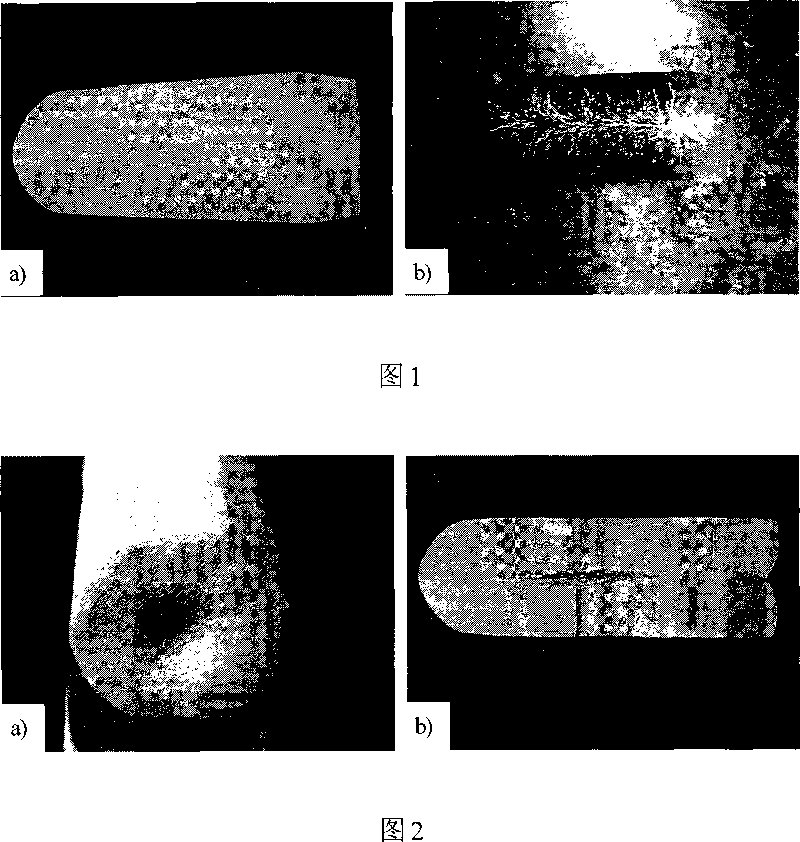Method for preparing low nickel content ternary TiNiHf shape memory alloy sheet material
A memory alloy and plate technology, applied in the field of low-nickel binary TiNi and ternary TiNiHf shape memory alloy plate preparation, to achieve the effects of modifying defects, preventing oxygenation, and controlling interaction
- Summary
- Abstract
- Description
- Claims
- Application Information
AI Technical Summary
Problems solved by technology
Method used
Image
Examples
Embodiment 1
[0028] Preparation of low-nickel ternary TiNiHf shape memory alloy sheets. The alloy was smelted on a 25kg vacuum induction furnace, and the 11mm thick plate was prepared through ingot surface treatment, ingot forging modification, defect removal, forging and rolling. Chemical composition is as table 1, and its preparation process is:
[0029] 1. The raw materials are sponge body, electrolytic nickel, and metal hafnium rods.
[0030] 2. Put the above raw materials into a CaO crucible for vacuum induction melting.
[0031] 3. The casting mold is a conical cast steel mold, and it is covered with thermal insulation material. Before casting, it is placed in a resistance furnace for 500-600°C / 3-5h heat preservation treatment (550°C / 4h in this example), and the power supply for smelting The frequency is in the range of 2000-5000Hz (3000Hz in this embodiment), and the vacuum degree is 1Pa; after the smelting, infrared and contact thermocouples are used for temperature measurement. ...
Embodiment 2
[0040] The difference from Example 1 is that the prepared low-nickel binary TiNi alloy sheet has a thickness of 3 mm and its composition is shown in Table 2.
[0041] Table 2 Composition of low-nickel binary TiNi shape memory alloys
[0042] element Ni f Ti O C element Ni Ti O C Nominal Composition (at%) 49.6 50.4 Measured composition (wt%) 54.5 Remain 0.052 0.011
[0043] [0042] The steel mold is subjected to heat preservation treatment at 600°C / 4h. The power frequency for alloy smelting is 3300Hz; after smelting, infrared and contact thermocouples are used to measure the temperature, and when the superheat reaches 120°C, casting is carried out; the forging temperature is 870°C, the forging speed is 2mm / s, and the deformation per fire is 5%. , Return to the furnace and anneal for 20 minutes (temperature 850-870°C), each heat deforms once along the circumferential direction of the ingot at a vertical angle ...
PUM
| Property | Measurement | Unit |
|---|---|---|
| thickness | aaaaa | aaaaa |
Abstract
Description
Claims
Application Information
 Login to View More
Login to View More - R&D Engineer
- R&D Manager
- IP Professional
- Industry Leading Data Capabilities
- Powerful AI technology
- Patent DNA Extraction
Browse by: Latest US Patents, China's latest patents, Technical Efficacy Thesaurus, Application Domain, Technology Topic, Popular Technical Reports.
© 2024 PatSnap. All rights reserved.Legal|Privacy policy|Modern Slavery Act Transparency Statement|Sitemap|About US| Contact US: help@patsnap.com








